Aintree - The Home of the Grand National
Home of the Grand National
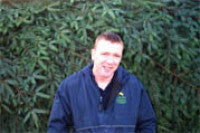
Aintree Racecourse consists of about 250 acres of grass land to maintain, of which 75 acres is made up of the three race courses, the Hurdle course, the Mildmay Steeplechase and the Grand National course. I have eight staff including myself to look after the courses, lawns and surrounding areas and two greenkeepers who look after the nine hole pay and play golf course, reputedly the longest nine-hole course in the British Isles. We currently have about 24,500 rounds played each year as well as regular daily use of the driving range.
In 2003 we will accommodate six race days at Aintree, which is less than the majority of the 58 courses around the country, but that enables us to provide a perfect surface for the Martel Grand National meeting in April.
Our general maintenance program at Aintree obviously includes a vast amount of grass cutting, with all the courses being cut three times a week during the growing season. Because the area is so large we don't collect the clippings but return them to the soil using large Turfmec and John Deere rotary mowers. With fences and hurdles surrounding the courses, strimming is probably the most labour intensive operation, and I have two lads working their way around the course, but in the summer it's like the painting of the Forth Road Bridge, because when the lads get all the way round, it's time to start strimming again. We have used different growth regulators with varying success, in my opinion, Shortcut providing us with the best results.
For the race days, the height of cut is at 100mm (4"), but for the rest of the time I like to reduce this down to about 48mm (2") to increase the density of the sward. In the days leading up to a meeting we allow the grass to grow so that there is more of a cushion for the horses.
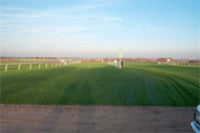
The next job is to treat the weeds on the course with a selective herbicide applied by our 12m boom sprayer; following this operation the height of cut is reduced, followed by a vigorous scarification using the Opico turf comb. This operation is carried out more for grass species management rather than thatch control.
Once the levels are back, we over seed with a Gannon seeder using a Mommersteeg Rye/Fescue mix. I tend to put down about 1000kgs of seed in April, but we also over seed in July, September, October and November using about 600kgs per application. 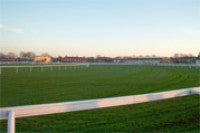
We vertidrain the whole course once a year, the soil make up at Aintree is firstly an organic sandy loam but is also very consistent around the whole course. The going on the course is the determining factor in horse racing so we may manipulate the going by using irrigation practices (not the only factor, but the principal one). We like to be on the soft side of good for national hunt racing at Aintree. There is a familiar scale of terms used, which go as follows; heavy, soft, good to soft, good, good to firm, firm and hard.
Vertidraining of the courses is carried out in July/August, this operation is performed by Mallinson (UK), but hopefully we can purchase our own machines in the near future so we can be more flexible with such a significant procedure.
Depending on the conditions, a hoof print will leave a six to twelve inch hole that needs to be repaired, with 120 or so horses running in a given meeting that is a very large number of divot repairs. We sort of worked out that each horse should bring a few tonnes of sandy loam with them to refill their holes.
After vertidraining we tend to re-compact with Cambridge rollers just before a race meeting. Because of the nature of our soil make up, we need to get back the stability; at other courses with higher clay content you tend to get divots coming out which can be replaced, here we just get holes because there is little resistance for the horses' hooves.

This year, we had quite dry conditions leading up to and during the National meeting, so we were irrigating approximately 75 acres of racecourse with between 5 and 10mm of water every evening. This job can take all night. We have a ring main around the course and we plug in moving rain guns. We also have 30m and 50 metre booms driven on tractors and hose reels to water as well. The water is taken from two boreholes; submersible pumps then feed the ring main.
We are currently carrying out a feasibility study on the irrigation system over the National course. This is consisting of a combination of 2 linear irrigators and static rain guns. Linear irrigators are used in agriculture and we are currently looking at adapting these slightly to ride over the top of the fences and over of the wing rails. Consistency of application is the critical factor in any irrigation procedure on the racing surface.
3-4 weeks before the National meeting, we fertilise with a 9:7:7 outfield fertiliser at 35g/square metre, only if soil temperature is over or around the 10 degrees Celsius threshold. If like this year this is below, we will apply a liquid fertiliser consisting of Urea/Nitrate based N source. The simple Nitrate source will promote some required growth and colour. Like all groundsmen/greenkeepers the climate will determine most of our maintenance operations and event day procedures. Hence the expression in "the lap of the gods". For us this is only too true.
Following overseeding procedures in October and November, weather permitting we will apply a bio-stimulant to the repaired areas, to assist any young seedlings that have arisen from the repairs. This is to encourage a healthy sward and to promote a dense sward for the Grand National meeting. Again this is all dependent on the climate from early December through to early April.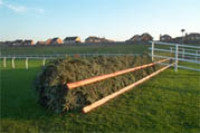
A major problem that we've encountered is the common leaf weevil, it's a root feeder that can destroy large areas of grass, and there is also a problem with leather jackets.
We apply an insecticide in the autumn; just as the leather jacket larvae are hatching out, the chemicals we use also manage to treat the common leaf weevil as well, so we manage to contain two problems at the same time. In conjunction with the pesticide we feed the grass with an autumn/winter fertiliser of 4:12:12 again at 35g per square metre, to assist any recovery in the event of a pest attack.
Just prior to the National, we stripe the course using our light fairway mower. The course has to look in pristine condition for this prestigious event.
During the meeting we have about 150 staff each day, these staff are commandeered from other courses around the country, the bulk being from Haydock Park. This is helpful, because I know that the staff coming in are already trained. The temporary staff are positioned around the course, and help my full timers with fence building, divotting and other duties.
We dress all the fences with spruce branches and birch, and this is a skilled job in itself. On the National course there are sixteen Grand National fences around the two mile track, most of which are jumped twice during the Martel Grand National. We have 8 Birch fences on the Mildmay course these are replaced every other year, so we do four each year.
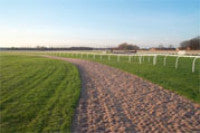
The fibresand has helped us immensely, when the horses were cantering down to the starts before a race, there was a lot of damage caused off track, this damage required repair. The fibresand canter down has the give in it for the horses and doesn't end up with big holes. After use we put a power harrow over it to loosen it up and prevent it compacting.
At a few points around the course we have crossings that allow vehicular traffic into the centre of the course, these roadways are also made of fibresand, these crossings are of a stone base, Terram and a 250mm depth of Fibresand. The National course actually crosses a proper main road(Melling Road) at two points. We used to use ash for the horses to cross the road, but in 2001 there was a lot of rain and it turned to a pudding, so we hurriedly brought in fibresand to replace the ash and have used this material since.
Other aspects of our work this year has included some landscaping of the internal areas of the course, we have put in a couple of plantation areas to beautify the area in front of the main stand.
We also have a motor track between the National course and the Golf course with about ten meetings a year. This is an additional maintenance area that needs to be swept of any debris, there are occasional crashes into fences if the cars leave the track.
The management have been very good when it comes to purchasing new machinery; we have a good stable of equipment (excuse the pun). We have a 12' Ride on rotary JD (John Deere) 1600, which is very versatile around the hurdles and fences, we have a 16' rotary Progressive tri-deck which is tractor driven, a JD 1145 single deck for going round the rails, a Grillo brush cutter for the banks, which with its low centre of gravity is very stable.

After the regular use machines we have items such as the Core Master 12 for the greens and tees, a 2.0m wide Gannon seeder, the Opico turf combs, a 12 m Allen boom sprayer and a Maschio power harrow. There is an array of strimmers and chain saws and other small items, we have a large building to store all of the equipment in, but more importantly a workshop, we try and do most of the machine maintenance ourselves.
I first came to Aintree to work on the golf course seven years ago, working under Terry Robinson, now lecturing at Myerscough. I've been the Courses Foreman for the last 3 years. When I first came there was little in the way of machinery. My remit is to manage the full time staff, race day staff, fencing, course materials and machinery budgets. The management are very good in providing the right kit for the job, as long as I have a good argument. This year I hope to add two verti-drains to our machinery fleet, probably a 2.6m and a 1.3m wide machine.
We can spread the wear on the course, by strategically moving the rails during the big meetings, so for each race the horses can be running on fresh ground. With the teams of lads coming in from other courses, there are units to move hurdles, repair fences, divot/backfill of the course and irrigate. It's a massive operation to oversee and we are well organised in advance of the meetings, but by the end of each meeting I'm absolutely shattered and I retire to the local for a few pints.
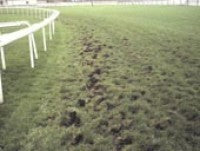

We are fortunate that we don't have more races, but the entire venue revolves around the National meeting. The course has to be immaculate for this historic race, so the management are careful in the use of the venue during the rest of the year.
Aintree is used for conferences and other events during the year, but the major revenue comes from the Martel Grand National. The Martel Grand National continues to be the most challenging event of the year, within the national hunt calendar.
I can honestly say that after assisting in the running of this meeting for the last 3 years, all 3 have been totally different. That in itself is the challenge that I enjoy - the unpredictable.
